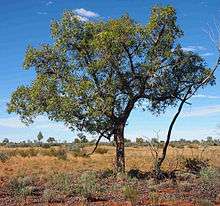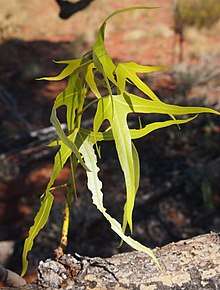Brachychiton gregorii
| Desert kurrajong | |
|---|---|
 | |
| Scientific classification | |
| Kingdom: | Plantae |
| (unranked): | Angiosperms |
| (unranked): | Eudicots |
| (unranked): | Rosids |
| Order: | Malvales |
| Family: | Malvaceae[lower-alpha 1] |
| Genus: | Brachychiton |
| Species: | B. gregorii |
| Binomial name | |
| Brachychiton gregorii F.Muell., 1862 | |


Brachychiton gregorii, commonly known as the desert kurrajong,[2][3] is a small tree of the genus Brachychiton found in northern and western Australia.[4] It was originally classified in the family Sterculiaceae, which is now within Malvaceae.
Description
The tree typically grows to a height of around 3 to 12 metres (10 to 39 ft)[2] with a canopy width of around 2 to 5 m (7 to 16 ft).[5] The evergreen leaves reach to 20 centimetres (8 in) in length and have three or five lobes in a long stalk. The leaves are shed in the dry months. It flowers between October and December producing inflorescences with bell-shaped pale-yellow flowers with a reddish margin. Following flowering black woody seed pods form that are up to around to 5 cm (2 in) in length and contain many seeds.[3]
Taxonomy
The species was first formally described by the botanist Ferdinand von Mueller in 1862 as part of the work Thalamiflorae. The Plants Indigenous to the Colony of Victoria. Several synonyms exist for the plant including; Clompanus gregorii, Brachychiton acerifolius var. gregorii, Sterculia diversifolia var. occidentalis, Sterculia gregorii and Brachychiton populneus var. occidentalis.[6]
The species name honours the explorer Augustus Charles Gregory who later became surveyor-general.[3]
Distribution
It has a scattered distribution in arid areas including the north western corner of South Australia where it is found on rock ridges, slopes and sand dunes. It is also found in the Northern Territory[3] and Western Australia where it is scattered throughout the Goldfields, Pilbara and Mid West regions where it grows in red sandy or loamy soils.[2]
Cultivation
The tree is sold commercially in seed form[7] or as a seedling where it is suitable for arid areas. It is drought resistant once established, is moderately frost tolerant, can grow in full sun or part shade in well drained soils.[5] It forms a large tuber from a young age and can be cultivated as a succulent bonsai.[7]
Notes
- ↑ The genus Brachychiton was traditionally placed in the family Sterculiaceae, but that family, along with Bombacaceae and Tiliaceae, has been found to be polyphyletic and is now sunk into a more broadly-defined Malvaceae[1]
References
- ↑ Stevens, Peter F. (29 January 2015). "Angiosperm Phylogeny Website". Retrieved 6 February 2015.
- 1 2 3 "Brachychiton gregorii". FloraBase. Western Australian Government Department of Parks and Wildlife.
- 1 2 3 4 "Brachychiton gregorii (Sterculiaceae) Desert Kurrajong". Seeds of South Australia. Government of South Australia. Retrieved 17 September 2018.
- ↑ "Brachychiton gregorii". Australian Plant Name Index (APNI), IBIS database. Centre for Plant Biodiversity Research, Australian Government.
- 1 2 "Brachychiton gregorii". Australian Native Plants. Retrieved 17 September 2018.
- ↑ "Brachychiton gregorii F.Muell". Atlas of Living Australia. Global Biodiversity Information Facility. Retrieved 17 September 2018.
- 1 2 "Brachychiton gregorii – Desert Kurrajong (seed)". Herbalistics. Retrieved 17 September 2018.